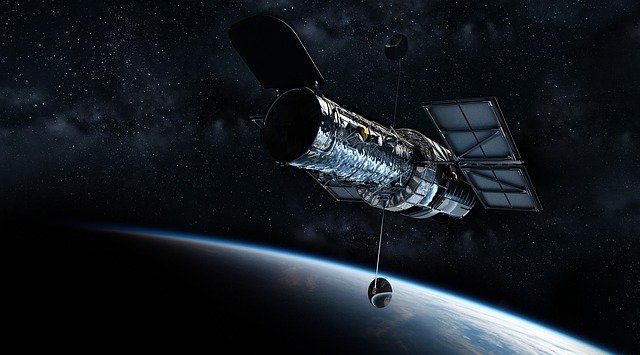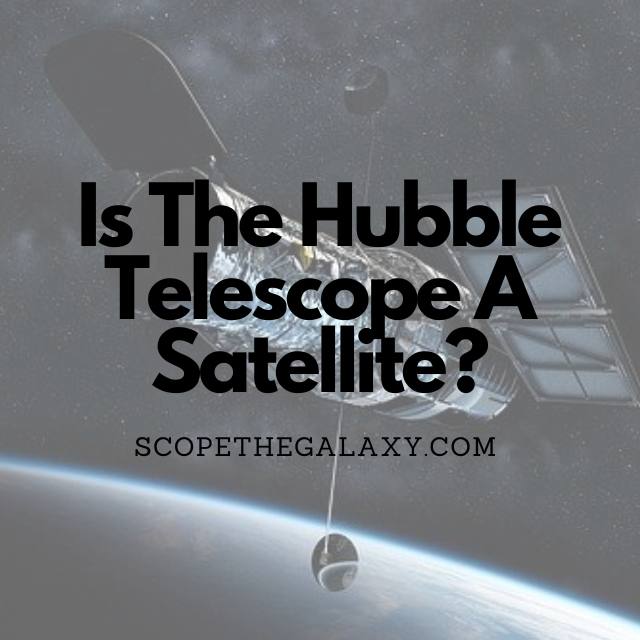*This post may contain affiliate links. This means we may make a commission if you purchase an item using one of our links*
A satellite is any object which orbits a star or planet. We can generally group satellites into two main types: natural and man-made. Natural satellites include the moon, while man-made objects include the Hubble Telescope, which sits in a low earth orbit.
Continue reading to discover the different types of satellites and how the Hubble Space Telescope fits into these categories.
What Are The Different Types Of Satellites?
Table of Contents
A natural satellite is an object that orbits a planet; it is not man-made and cannot be controlled by humans. Natural satellites are often called moons because they orbit around a planet. Many planets in our solar system have their own natural satellite, including Earth, which has its moon.
Man-made satellites are machines that humans launch into space to orbit a specific body, such as a planet. Some satellites have cameras and can be used for photographing the Earth or other planets or measuring things like air quality and ocean currents.
We can categorize these satellites into four main types: Low Earth Orbit, Geostationary Earth Orbit, Medium Earth Orbit, and Highly Elliptical Earth Orbit.
Low Earth Orbit satellites are the most common type of satellite, orbiting the Earth at an altitude of about 500 – 1500 kilometers. Low-earth orbit satellites provide many benefits because they can cover a large area with high-resolution images.
Medium Earth Orbit satellites – or MEOs – orbit the Earth at a distance of between 6,000 to 20,000 km. They function similarly to LEOs but cover a much larger area of Earth. Their slower speeds mean that a complete orbit takes around six hours (compared to one-and-a-half to two hours for LEOs).
High Earth Orbit satellites are employed when high latitude coverage is required for special applications. They are the only type of satellite that doesn’t follow a circular orbit but travels in an elliptical path around a planet.
Geostationary Earth Orbit (GEO) satellites are used for communication purposes and usually stay in one spot above the equator (about 36,000 km from Earth’s surface). This stationary orbit differentiates them from the other types of satellites and means they travel around Earth at roughly the same speed as the Earth is turning.
Why Is The Hubble Telescope A Satellite?

A man-made satellite is an artificial object intentionally placed into orbit around the Earth or another celestial body. Satellites are used for many purposes, including communications, weather forecasting, and observation.
Hubble is the most famous and successful space telescope scientists have ever launched. It orbits around the Earth at an altitude of about 600 km, about 400 km above the Earth’s surface. This makes it an LEO or Low Earth Orbit satellite.
Hubble’s primary goal is to observe the Universe and its objects with clarity, allowing many groundbreaking discoveries. The Hubble has been instrumental in proving the existence of dark matter, dark energy, and exoplanets.
The Hubble Space Telescope has a mass of 12,246 kg. The telescope comprises two major components: the optical and support systems. The optical system includes a 94-inch diameter mirror that can be moved in any direction by remote control to point toward any part of the sky.
The support systems include gyroscopes, computers, batteries, and reaction wheels, which are used to keep it in orbit and pointed toward Earth at all times.
How Is The Hubble Telescope Able To Stay In Orbit?
Satellites are held in orbit by the Earth’s gravitational pull, which is strong enough to hold the object in orbit. For an object to stay in orbit around Earth, there must be a balance between the Earth’s gravitational pull and the object’s escape velocity.
The escape velocity is the speed at which an object travels to escape Earth’s gravitational pull. The escape velocity of the Hubble Space telescope is approximately eight km/s (or 27,300 km/h).
Man-made satellites are sent into space via rockets launched at an angle that will take them into orbit around the Earth. This is done by launching the rocket at a 45-degree angle and then tilting it to a 90-degree angle.
Once in orbit, the rocket will begin to circle Earth every 90 minutes or so. It will also move farther away from Earth’s surface as it orbits, eventually reaching a distance of about 600 kilometers.
Some rockets are designed to release satellites into orbit; others are designed to bring them back down to Earth at the end of their missions.
Summary
A satellite is any object – natural or man-made – that orbits the Earth (or any other planetary body). The Hubble Space Telescope is a satellite of Earth because it sits in a low-level orbit of our planet and has done so for many years.
This position has allowed scientists to capture phenomenal new images of our Universe. Further technological advances will give us an even clearer look into what lies beyond.
References
Types of Satellite Systems – Javatpoint
What Is the Hubble Space Telescope? | NASA
Satellites – The Hubble Space Telescope (spacesim.org)
How are Satellites Launched Into Orbit? | Globalcom Satellite Phones (globalcomsatphone.com)

